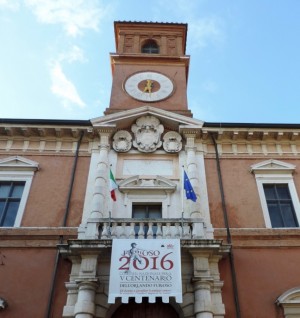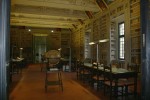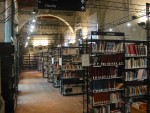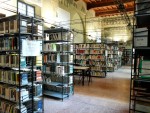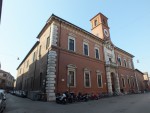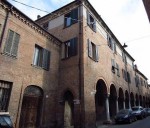Ariostea Public Library
The Ariostea Library, housed within Palazzo Paradiso, has long established itself as a central hub of Ferrara's cultural life. Among the distinguished citizens who remembered it with affection is the writer Giorgio Bassani, who used to spend a significant part of his time there.
The first room of the Public Library: Ariosto Room
In 1746, a room on the noble floor was allocated for the nascent library, designed by Gaetano Barbieri with the collaboration of Agapito Poggi. Proceedings favouring the incorporation of the Bentivoglio Library continued throughout 1749, affecting relations between the family and the Magistracy. Giovanni Andrea Barotti (Ficarolo, 1701 - Ferrara, 1772), the first prefect of the Public Library from 3 June 1747, was well acquainted with the Bentivoglio Library, having been the librarian of Marquis Guido Bentivoglio. Hence, he carried out the appraisal for the Magistracy, while for the Bentivoglio family, Abbot Branchetti, a former prefect of the Public Library of Bologna, conducted it. The acquisition, for which the price of 7,400 scudi was paid, was approved on 2 October 1749, while Count Agostino Novara was Judge of the Wise, and it was notarised on 8 November by Ignazio Borsetti. In 1750, the decorations of the room were completed by Giuseppe Facchinetti with the contribution of Giacomo Filippi, the furnishings, and the stucco creations (busts, emblems, and putti) by Alessandro Turchi.
On 7 June 1801, the first room of the Public Library was dedicated to Ludovico Ariosto. By order of the Bonapartist general Sextius Alexandre François Miollis, the urn containing the ashes of the poet was transported from the church of San Benedetto to Palazzo Paradiso, where it was interred in the funerary monument designed by the architect Giovanni Battista Aleotti (Argenta, 1546 - Ferrara, 1636). The marble execution from Verona is by the Mantuan sculptor Alessandro Nani, active in Ferrara in the years 1610-1612. The allegorical decorations on the wall, framing the mausoleum, were created by Giuseppe Santi (Bologna, 1761 - Ferrara, 1825).
The Ariosto Room also houses important memorabilia, including: the portrait of Ludovico Ariosto, a copy by an unknown artist of the original by Dosso Dossi, oil on canvas, from the 17th century, donated to the Ariostea Library in 1920 by Antonia and Giuseppe Gatti Casazza on the occasion of their daughter Malvina's wedding to Marquis Renzo Paolucci delle Roncole; the scagliola bust of the poet Vincenzo Monti, created by Abbondio Sangiorgio (Milan, 1798-1879), as well as the secretaire, the crucifix, and his heart; the bronze bust of the poet Giosuè Carducci by the sculptor Tullio Golfarelli (Cesena, 1852 - Bologna, 1923).
The Garden of the Finzi-Continis at Palazzo Paradiso
One particularly prized item stands out among the autograph manuscripts kept at the Ariostea Library. It is a well-known work of twentieth-century Italian literature, probably most famous of Giorgio Bassani's expansive oeuvre: The Garden of the Finzi-Continis
The manuscript was donated by a lawyer named Federigo Foscari coinciding with the festivities held to mark the centennial of the writer’s birth. Foscari had received the manuscript from his grandmother, Teresa Foscolo Foscari, with the task of keeping it safe for as long as she lived. The book was given to her by Bassani himself, who wrote in a letter: ‘Dear Teresa, without your help, The Garden of the Finzi-Continis would never have been written. I hope that these notebooks stay with you always. Venice, 17 December 1961’. In 2007, upon his grandmother’s passing, Federigo Foscari decided to donate the text to the city of Ferrara.
The novel had a ‘very long incubation period’ according to the author. ‘A few weeks ago, tidying up some old papers, I happened to find this draft of the story, which I had completely forgotten about [Frammento 1942, -Ed.]. They’re words set to paper around 1942, I think, a reaction to the emotions I felt about a real event: the death of a friend. They are undoubtedly the first attempt at writing The Garden of the Finzi-Continis’ [G. Bassani, note in ‘Frammento 1942’, in Bassani. Racconti, Diari, Cronache (1935-1956), Ed. P. Pieri, Feltrinelli, Milan 2014, p. 340]. That story and the contemporary Caduta dell’Amicizia (Loss of Friendship) (ibid., p. 97s.), as confirmed by scholar Piero Pieri, are the 'first records of what would become The Garden of the Finzi-Continis (ibid., p. 97; cfr. ibid., p. 335). Written entirely between 1958 and 1961, the novel was first published in 1962 by Einaudi. That same year, it won the Viareggio Prize, but the editing and revision that the author often subjected his works to meant it wasn’t the definitive version, and changes were made for the publication of Romanzo di Ferrara(Novel of Ferrara), into which The Garden of the Finzi-Continis was incorporated. Further modifications were made for subsequent editions, in 1976 and 1980. The donation of the manuscript to the Ariostea Public Library is an important event for textual criticism studies on Bassani, and for Ferrara, the city to which this document and the events it recounts are inseparably linked.
In honour of this important donation, a portion of the garden of the Ariostea Library was dedicated to Teresa Folscolo Foscari, including the installation of a commemorative plaque: ‘To the Countess Teresa Foscolo Foscari / (1916 - 2007) / This part of the garden of Palazzo Paradiso is dedicated // The Ariostea Library / holds / the autograph manuscript of The Garden of the Finzi-Continis / that Giorgio Bassani dedicated to her / and that / her grandson, Federigo Foscari / then donated to the city of Ferrara / 2017’.
It should also be noted that the Ariostea Library was an important place for young Giorgio Bassani. He was a regular visitor until the issuing of Italy's racial laws, which forbade him and other Jews from accessing its services and the very building itself. This expulsion was relived in narrative form by Bassani’s literary alter ego Bruno Lattes in ‘Clelia Trotti’s Last Days’, a tale in Five Stories of Ferrara (G. Bassani, Gli Ultimi Giorni di Clelia Trotti, in Cinque Storie Ferraresi, Opere, Mondadori, Milan 2001, p. 145).
That wound was symbolically healed in the 1980s, when the writer's library card was given back to him during a public ceremony.
The works of Ariosto
The library preserves over 650 copies of editions of Ariosto's works, as meticulously documented by Alessandra Chiappini, including some very rare ones such as the editio princeps of Orlando Furioso (Ferrara, Giovanni Mazzocchi, 1516), two copies of the first edition in 46 cantos (Ferrara, Francesco Rossi, 1532), and the editio princeps of the Satires (Ferrara, Francesco Rossi, 1534).
Other relics are preserved as witnesses to the tireless work of the poet, such as the armchair and the inkwell: 'The elegance of the latter in bronze contrasts with the almost coarse simplicity of the walnut wooden chair. It is said that the inkwell, gift of Alfonso, was fused by him with the drawing of Ariosto; it overlapped a cherub holding the index finger of his straightened hand above his lips. Many biographers of Ariosto claim that this silent love is an emblem of “his discretion in his fortunate encounters” (Antonelli 1838, p. 10).
Riminaldi Room
The Ancient Hall of Conclusions, later used for Reading, is now the Consultation Room for manuscripts and rare books. It was named in 2006, following the restoration, after Cardinal Giammaria Riminaldi (Ferrara, 1718 - Perugia, 1789), Auditor of the Rota at the Roman Curia. He worked to support and enrich the Ferrara Public Library. His love for his city and the Public Library never wavered. In 1780, he sent around 1000 volumes from Rome, including rare editions and manuscripts, on local sacred and profane history, forming the nucleus of the Ferrarese Collection. He also laid the foundations for the formation of the three collections that have always been the soul of the library: the Ariostea, the Savonaroliana, and the Tassiana. In 1782, he donated the largest contribution: around 2000 volumes, mostly folios and quartos, placed in 20 large boxes, containing valuable and rare works with splendid bindings.
The room also houses 18 portraits that constitute the Riminaldi gallery donated by the cardinal between 1763 and 1781. Later, the portrait of Cardinal Luigi Giordani, archbishop of Ferrara until 1893, the year of his death, was added. The gallery represents part of the donation made during his cardinalate in Rome, rich in various works of art, including sculptures, mosaics, objets d'art, and books, some belonging to his collection, others commissioned or purchased specifically to enrich Palazzo Paradiso. All the ecclesiastics depicted form a series and are represented in the same position, half-length, and in cardinal's attire. The room is adorned with three globes by Matteo Greuter (Strasbourg 1556 - Rome 1638): one terrestrial in the 1632 edition dedicated to Giacomo Boncompagni, Duke of Sora, Marquis of Vignola, and Count of Aquino; two celestial in the editions of 1636 and 1695.
The city library
With a heritage of approximately half a million volumes, the Biblioteca Ariostea is today the main public library in the city. Established in 1753 in the historic Palazzo del Paradiso, initially intended to support university teachings, it has gradually assumed an increasingly important role in the field of studies and local historical memory. This is related to the development of its collections, primarily characterized by precious private donations, bequests from Ferrarese families, and annexations resulting from the suppression laws against religious orders.
Starting from the 1980s, the Palazzo underwent complete restoration. The works, concluded in 2007, completely redefined its spaces, exclusively dedicating them to the library and new services for readers. The goal was to complement the traditional functions of a historical and conservation library with those of a modern public library. Alongside the rooms for study and consultation of rare and ancient books, open-shelf areas were introduced, housing books, magazines, and newspapers, as well as a Children's Room and zones dedicated to the use of new technologies, equipped with Internet navigation stations and Wi-Fi areas. Even the external spaces, the court of honour, and the garden (formerly the Botanical Garden) were furnished as open-air reading rooms during the summer months, providing spaces for both study and socialization. In the large ground-floor hall, dedicated to Giuseppe Agnelli (1856-1940), who directed the library for over forty years, daily intense cultural promotion activities take place, including conferences, conventions, and author meetings, revolving around the world of books and reading. This is done in collaboration with numerous cultural associations in Ferrara.
In recent years, the library has been developing a rich program of educational initiatives aimed at the world of schools, with the aim of introducing children and young people to reading and familiarizing them with libraries and archives.
The Library and Archives Service
Since 1986, the libraries of the Municipality of Ferrara have joined the project of the National Library Service, the network of Italian libraries promoted by the Ministry of Cultural Heritage and Activities and Tourism. Since 2005, with the addition of the libraries of the University of Ferrara and the Province, they have become part of the Unified Ferrara Pole. Starting from that year, following the provisions contained in the Law of April 7, 2014, No.56 (known as the Delrio law), which redefines the functions of the provinces, the Municipality of Ferrara, through the Library and Archives Service, has taken on the coordination of the new Bibliopolis Network, which brings together the libraries of the municipalities in the Ferrara area that were under the Province of Ferrara, representing them within the framework of the Convention of the Ufe Pole. The intervention of the Library and Archives Service has allowed the continuation of the Ufe Pole and not interrupt the provision of some library services, particularly appreciated by readers, such as interlibrary loans (Interlibro). Furthermore, since June 2015, the Municipality of Ferrara has extended the new digital lending service to all libraries in the Ufe Pole, giving all registered users of Ferrara libraries the opportunity to borrow books to read in digital format through their own device (PC,tablet, or e-reader). In 2015, at the level of the Library and Archives Service, specific projects were identified and carried out, representing important steps in enhancing the structures and resources present in them: the printed inventory of the Lanfranco Caretti Archive and the exhibition dedicated to the Ferrarese scholar on the occasion of the centenary of his birth; the cataloguing of the library of the director Michelangelo Antonioni; the start of the construction site of Casa Niccolini, which will host the new Children's Library.
Bibliography
- Giuseppe Antonelli, Sopra la Biblioteca pubblica di Ferrara: osservazioni del cav. Valery, Bresciani, Ferrara 1838
- Alessandra Chiappini (a cura di), Palazzo Paradiso e la Biblioteca Ariostea, Editalia, Roma 1993
- Giorgio Bassani, Gli ultimi giorni di Clelia Trotti in Opere, Il romanzo di Ferrara, Mondadori 2001
- Giorgio Bassani, nota a Frammento 1942, in Giorgio Bassani, Bassani. Racconti, diari, cronache (1935-1956), cur. P. Pieri, Feltrinelli, Milano 2014
- Biblioteca Comunale Ariostea, Il dono Segre Debenedetti alla Biblioteca Comunale Ariostea, Comune di Ferrara, Ferrara 2016
Sitography
Fototeca
Related places
Related Itineraries
Compiling entity
- Assessorato alla Cultura e al Turismo, Comune di Ferrara
Author
- Angela Almirati
- Stefania De Vincentis
- Barbara Pizzo

